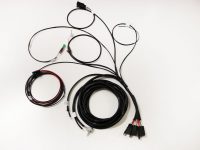*****NOTICE TO CUSTOMER: If there is a problem suspected with the wiring harness, call Off Road Solutions. DO NOT cut, alter, or dissect the ORS conversion harness. Off Road Solutions accepts no responsibility for a harness that has been tampered with – NO EXCEPTIONS.*****
Important: In its original application, Toyota uses a computer to control the operation of the E-Locker. In this system, various inputs are used to control differential operation, such as 4WD mode and vehicle speed. This computer-controlled system is designed for operator safety and differential reliability. When using the ORS E-Locker Wiring Harness, the operator is given full control of the locker operation. This makes the driver responsible for judging the appropriate timing of E-Locker operation.
- The locker switch is the proper size to fit the typical Toyota “cutout” panel found in the dashboard near the steering column. The switch lead is designed to mount near the steering wheel or center console area.
- The relays are designed to be mounted under the dash in the driver side or near the driver side kick panel. Connect the ground terminals to a suitable body ground location.
- The wire labeled “to ignition “on” source” should be spliced to a power source that is 12V only when the key is in the “on” position. This will only allow the locker to function when the ignition is on. If full time operation is desired, this should be connected to a constant 12V power source, such as the battery positive terminal.
- ‘95 and earlier 4Runner/Truck: Route the battery and locker leads under the dash to the RH side, then through the RH side hole/grommet in the firewall. If a hole does not exist, drill a hole large enough to clear the e-locker connector. Be sure to install a grommet around the harness as it passes out the firewall to prevent wire damage.
- FJCruiser/FJ80 LandCruiser/96 and newer 4Runner/Tacoma: Route the battery and locker leads through the LH side of the firewall, using an existing grommet. Be sure the grommet protects the harness from resting against the sheet metal.
- Route the battery lead to the battery and connect the eyelet to the positive terminal.
- Route the locker lead down the firewall along the brake lines.
- In front locker applications route the locker lead forward along the frame and then drop down above the axle to the differential and connect to the locker. On coil spring systems, it is advised to run this lead down the upper control arm.
- In rear locker applications, route the locker lead rearward along the frame to the rear suspension. Route the lead down the brake hose or an upper control arm, to the rear differential and connect to the locker.
- Be sure all wiring is secure by way of zip ties, routing clamps, etc. Be sure the wiring harness does not touch and sharp edges and is clear of any heat or moving parts.
- Many electric-locking differentials will have a 2-wire connector in addition to the main connector. This connector is only used when the indicator upgrade is built into this harness.
- If a dual-light or OEM switch is used: locate the ORS wire labeled ‘to illumination + wire’. Splice this wire to the 12v positive wire in any illumination connection under the dash, such as lights inside switches. This is often a green wire, sometimes w/ a stripe; that will have 12v with the tail lights on. Locate the ORS wire labeled ‘to illumination rheostat or body ground’. If dimming ability of the illumination light in the switch is desired, splice this wire to the ground side illumination wire at the same source. This is often a white wire w/ a green stripe that will have variable resistance to ground, depending on the rheostat position. If dimming ability is not desired, connect this wire to body ground.
NOTE: In some rare applications the Toyota limit switch in the actuator is oriented in the opposite direction. In this case your locker would be on w/ the switch (and light) “off”, and the locker would be off when the switch was “on”.
To correct this condition, first disconnect the negative battery terminal. Remove the relay labeled “3” from its connector. Using the engraved ‘terminal’ labels on the bottom of the relay as a reference, locate terminals ‘87’ and 87a’ in the connector. Swap the positions of the 87 and 87a wires in this #3 connector. Using a long pick and a flashlight, unlock the terminal from the connector; this is done from the relay side of the connector.
Before re-installing the wires, be sure the lock tab on the terminal is still bent out. Push the wires into their new positions until a “click” is heard. Make sure the terminal is locked into place and re-install the relay. Connect the negative battery terminal.




